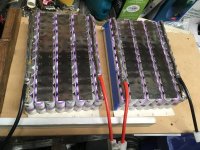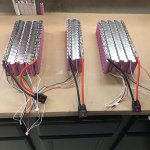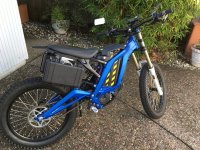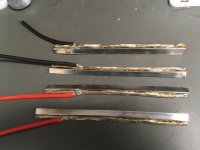Ianrobbens
1 µW
- Joined
- Mar 17, 2019
- Messages
- 4
Hello all
I’m in the process of building my 2nd ebike, the 1st was a great success but I’m setting my sights way higher with the new one.
It’s an 8000w Qs motor on an enduro frame from our friends in China!
It’s a beast!


The part I need help with is the battery, this is my 2nd 18650 pack I’ve ever made and I don’t want to get it wrong not only due to fire hazard but even more so for my wallet! I’m sure you guys can appreciate 200 Samsung 30q cells aren’t cheap!
My question relates to the nickel strip.... how many layers of .15 7mm nickel would I need for the series and parallel connections?
I’ve scrawled this forum and watched endless videos but I can’t seem to find much info regarding how many layers of nickel I would need to make a 150amp pack that won’t burst into flames or short out the nickel under heavy loads.
I’m using a 150 amp Sabvoton controller and 150amp bms and the motor can defo handle the power!
Here is my logic....... each strip of nickel can handle 5amps, the cells can handle 15amp continuous, so would I need 1 layer for the parallel connections and 3 layers for the series connections?
Or would I need 3 layers for the 1st series connections, 6 layers for the 2nd series connections and so on? If that’s the case then I’m Gona need a trailer to carry the nickel clad battery!
Any help from you battery/electronic geniuses would be very much appreciated.
Thanks in advance...... Ian
I’m in the process of building my 2nd ebike, the 1st was a great success but I’m setting my sights way higher with the new one.
It’s an 8000w Qs motor on an enduro frame from our friends in China!
It’s a beast!
The part I need help with is the battery, this is my 2nd 18650 pack I’ve ever made and I don’t want to get it wrong not only due to fire hazard but even more so for my wallet! I’m sure you guys can appreciate 200 Samsung 30q cells aren’t cheap!
My question relates to the nickel strip.... how many layers of .15 7mm nickel would I need for the series and parallel connections?
I’ve scrawled this forum and watched endless videos but I can’t seem to find much info regarding how many layers of nickel I would need to make a 150amp pack that won’t burst into flames or short out the nickel under heavy loads.
I’m using a 150 amp Sabvoton controller and 150amp bms and the motor can defo handle the power!
Here is my logic....... each strip of nickel can handle 5amps, the cells can handle 15amp continuous, so would I need 1 layer for the parallel connections and 3 layers for the series connections?
Or would I need 3 layers for the 1st series connections, 6 layers for the 2nd series connections and so on? If that’s the case then I’m Gona need a trailer to carry the nickel clad battery!
Any help from you battery/electronic geniuses would be very much appreciated.
Thanks in advance...... Ian





